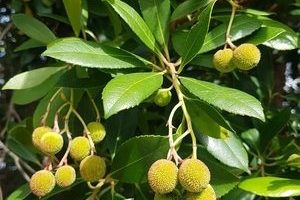Arbutus unedo
Common Names
Origin
It is native to Mediterranean countries and western Asia where it can be found growing wild. Portugal is currently the leading global producer of fruit. A little aside – Madrid’s Coat of Arms contains a bear and a strawberry tree.
Climate
It is a long-lived sub-tropical species adapted to open conditions, long hot dry summers and wet winters; nevertheless it can grow in the wet summers of western Ireland where archaeological digs indicate its presence >4000yrs BP. Mature plants respond to drought conditions by reducing leaf exposure and stomatal conductivity. There is strong re-sprouting ability after fires that might have burnt all above-ground parts, and mature trees can tolerate temperatures down to -12oC.
Plant Description
An evergreen long-lived shrub or small tree, up to 4-8m tall (often smaller) and about the same width, with reddishbrown bark that becomes flaky with age. The simple glabrous dense leaves, light green when juvenile and darker when mature, are alternate, leathery, elliptic, 4-10cm long, 2-3cm wide and have a serrated margin. Seedlings have a long taproot and when mature and it’s this feature which enables it to withstand dry periods. The species exhibits wide genetic and morphological variability. .
Relatives
Ericaceae Family, with 12 species in the genus. Other plants in the family grown for fruits include blueberry and cranberry.
Soils
Provided the soil is well-drained it will grow in most soil types, including those where other species will struggle. A pH range of 5-7.2 is preferred.
Propagation
Seeds are normally used as vegetative propagation by cuttings can be difficult. There is no dormancy so stratification is not required. If dried seeds are not stored for too long (ie <2 years), germination at 15oC is rapid with high success rates (80-90%).
Cultivars
Most cultivars have been selected on a non-fruiting basis as it is most commonly grown as an attractive ornamental plant. However a few of these produce tasty fruit and when propagated vegetatively will fruit faster and more reliably than seedlings. Some named varieties include Compacta (dwarf), Elfin King and Rubra (pink flowers). Studies focussed on optimization of fruiting qualities are virtually non-existent.
Flowering and Pollination
Inflorescences are drooping panicles of 15-30 hermaphrodite fragrant flowers. There are 5 basally connate oval-deltate sepals. The 5 creamy-white (sometimes pale pink) petals are joined nearly their full length to form an urn, inside which are 10 stamens, with a globose stigma and 5 locular ovary, with each locule containing several ovules. Pollination is by insects, with bees strongly attracted to the flowers, mainly for nectar but also pollen.
Cultivation
Given the long tap root, take care when transplanting. Young plants respond to good watering, whereas mature plants are more conservative in their needs. Water EC above 90mS/m will negatively affect growth. The species prefers full sun but will still fruit with some shade. It usually needs little additional fertilization, but will crop better if watered in dry periods. Mycorrhizal associations of the arbutoid type can form that assist in plant nutrition and resistance to unfavourable biotic and abiotic conditions.
Wind Tolerance
Reasonably wind tolerant if not overly hot and drying. It is even used in some places as a low wind break.
Pruning
It usually develops into a well-rounded dense canopy that needs little attention. Trees may give better yields than bush forms. .
The Fruit
The fruit is a globose berry, 1-2cm in diameter, with a pebbled skin that begins green-yellow, then changes to bright red when ripe and has 5-15 small seeds within the flesh. Vitamin C is 2-5 times that of an orange, sugars can be 10-30% depending on variety, and health-promoting antioxidant levels are higher than many other fruit.
Fruit Production and Harvesting
Fruit take about 12 months to mature and ripen, so you can have fruit and the current season’s flowers on the tree at one time. Mature trees can produce up to 5-10kg/tree, and fruit are best picked when fully ripe over an extended period in late autumn/winter. They do not store or transport well.
Fruit Uses
Flavour for seedling-grown plants is commonly not appealing. Fruit is commonly made into jams, jellies and marmalades but most is used to produce alcoholic beverages. In native areas, a bitter-flavoured but highly-valued honey is also made. Occasionally there are chance seedling varieties that have better fresh eating qualities, and fruit from these should be picked when fully ripe when there is a reduction in tannins and increase in sugars. Historically various plant parts have been used in traditional medicines for all sorts of ailments but there’s a scarcity of scientific studies in humans to reliably establish their value.
Pests and Diseases
These are not a major problem, but aphids and Phytophthora spp can attack plants and birds are attracted to the fruit.
Comments
The strawberry tree is a most attractive, small evergreen species which looks beautiful in autumn/winter with masses of both flowers and bright red fruit amongst its dense green foliage. If you plant one for eating fresh, try and ensure it is a graft or a cutting from a plant you know produces tasty fruit.
